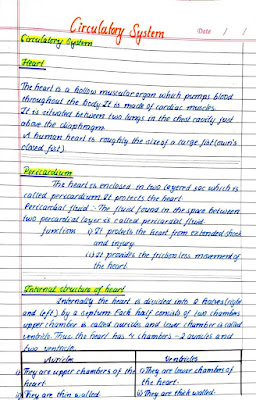Blood Circulation in Human Body
Blood is a red-colored fluid connective tissue that circulates in the arteries and veins of humans and other vertebrate animals, carrying oxygen to and carbon dioxide from the tissues of the body.
The main functions of blood are as follows:
- It carries oxygen and provides it to all the parts of the body.
- It contains WBC which protects our body from bacteria, viruses etc
- It transports digested food to various parts of the body.
- It transports harmful substances like carbon dioxide, urea, uric acid etc. to the excretory organs.
The components of blood are as follows:
Plasma
Red Blood Cells (RBC)
White Blood Cells (WBC)
Platelets
Plasma is important because plasma contains carries harmful substances from the body. It also helps in the transportation of nutrition. It also controls the flow and composition of water in the blood.
The functions of plasma are as follows:
- It helps in blood clotting at the wounds.
- It helps in transporting hormones secreted from endocrine glands.
- It transports digested food to different parts of the body.
- It balances the water content of the blood.
Red Blood Cells (RBC)
RBCs are circular, the biconcave fluid which is formed in the bone marrow. They are red in color due to the presence of hemoglobin, scarcity of which leads to anemia. They are small in size and helps in respiration
White Blood Cells (WBC)
They are colorless and irregular in shape which plays an important role to fight against the disease. They are formed in the bone marrow and lymph glands. The excess in the number of WBC leads to leukemia.
Platelets
Platelets are colorless oval cells produce in the bone marrow and die in the spleen. They have a very short life span. They help in healing the wounds.
The blood vessels that take part in blood circulation are arteries, veins and, capillaries.
The functions of arteries are:
- To carry oxygenated blood from the right ventricles to the lung for purification.
- The pulmonary artery carries deoxygenated blood from the heart to the lungs.
The functions of veins are:
- To carry deoxygenated blood from the lungs to the left auricle of the heart.
- The pulmonary veins carry oxygenated blood from the lungs to the heart.
The functions of capillaries are:
- To provide a definite path for the flow of blood
- To transfer the molecules of glucose, water, oxygen, hormones to the cells and tissues
Blood pressure:
It pressures exerted by the flow of blood on the walls of the arteries. The pressure exerted when the ventricle is contracted is called systolic pressure. The pressure exerted when the ventricle is relaxed is the diastolic pressure.
Download the whole note: Download pdf





























0 Comments